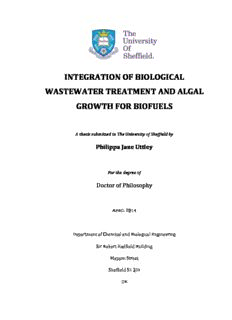
integration of biological wastewater treatment and algal growth for biofuels PDF
Preview integration of biological wastewater treatment and algal growth for biofuels
INTEGRATION OF BIOLOGICAL WASTEWATER TREATMENT AND ALGAL GROWTH FOR BIOFUELS A thesis submitted to The University of Sheffield by Philippa Jane Uttley For the degree of Doctor of Philosophy APRIL 2014 Department of Chemical and Biological Engineering Sir Robert Hadfield Building Mappin Street Sheffield S1 3JD UK For Graham and Jennie, with love ABSTRACT This thesis is concerned with the production of biofuels from microalgae that can be grown in wastewater on marginal land. Algal-derived biodiesel is a promising alternative to both the finite reserves of fossil fuels and also the current biofuel crops that take up agricultural land. The case for coupling biological wastewater treatment to the production of algal biodiesel is a compelling one that is explored in this research using a combination of mathematical modelling and laboratory experiments. Algae utilise by-products of the wastewater treatment process such as carbon dioxide, nitrate and ammonia. In this work, a mathematical model of an integrated wastewater treatment and algal cultivation system is presented. The model contains two units: an activated sludge unit for secondary wastewater treatment and a pond for the cultivation of algae. These units have both liquid phase and gas phase integration. For the liquid phase, the treated effluent from the activated sludge unit is transferred to the algal pond to provide nutrients for algal growth. The model also incorporates gas-phase integration whereby the CO rich off-gas 2 from the activated sludge unit is captured and used to enhance the algal growth. In addition, the O enriched off-gas from the algal pond is recycled back to improve 2 dissolved oxygen levels in the activated sludge unit. The mathematical model uses equations for algal growth that were developed using laboratory experiments to measure the effect of dissolved CO , nitrate and 2 ammonia on the growth kinetics of a typical strain of freshwater alga: Chlorella sp.. The model includes the industry standard Activated Sludge Model No. 3 for wastewater treatment. An economic profit function is used in the model to find the optimal pattern of gas phase integration to maximise Net Present Value over a specified project lifetime. For the case considered, the model predicts that integration using the gas and liquid exchange described above is necessary for a profitable outcome. This is a general approach that can be used to retrofit biofuel production onto an existing wastewater site, or design a new integrated system from first principles. 5 6 ACKNOWLEDGEMENTS I would like to take this opportunity to extend my gratitude to my primary supervisor, Dr Stephen Wilkinson, whose encouragement and guidance made this work possible. His enthusiasm in explaining concepts that were completely new to me has been very much appreciated. Steve’s innovative approach to problem- solving and experimentation always kept things interesting; I feel lucky to have had such an imaginative supervisor throughout the course of this research. I am very grateful to my secondary supervisor, Dr Jim Gilmour, from the Department of Molecular Biology and Biotechnology for advising me on all things algal. Jim has shown great patience in explaining fundamental biology to a chemist, even when I’ve asked for clarification on the most basic of concepts. I very much appreciate the time and knowledge afforded to me, as well as the space to work in a very busy laboratory. I would further like to thank: Dr Stephen Palmer and MWH, for funding; The E- Futures Doctoral Training Centre, its Director, Prof Geraint Jewell, Programme Manager, Dr Neil Lowrie, and former Director, Prof Tony West; The Engineering and Physical Sciences Research Council (EPSRC) and the RCUK Energy Programme. Thanks also to my E-Futures colleagues for advising me on subjects outside my own expertise, and to the members of Jim’s group who helped me in the lab with equipment and algae. Last but not least, my husband and daughter – thanks for making me smile at the end of each day. 7 8 TABLE OF CONTENTS ABSTRACT ..................................................................................................................... 5 ACKNOWLEDGEMENTS ................................................................................................ 7 TABLE OF CONTENTS .................................................................................................... 9 LIST OF FIGURES ......................................................................................................... 13 LIST OF TABLES ........................................................................................................... 15 NOMENCLATURE ........................................................................................................ 17 CHAPTER 1 - INTRODUCTION ..................................................................................... 21 1.1 Background .................................................................................................. 21 1.1.1 The fuels crisis and climate change...................................................... 21 1.1.2 Biofuels ................................................................................................. 24 1.2 Project Aims ................................................................................................. 26 1.3 Contributions and Thesis Structure ............................................................. 29 CHAPTER 2 - LITERATURE REVIEW ............................................................................. 30 2.1 Microalgae ................................................................................................... 30 2.1.1 Characteristics and requirements for growth ...................................... 30 2.1.2 Algal biofuels ........................................................................................ 34 2.2 Biological Wastewater Treatment ............................................................... 36 2.2.1 Overview .............................................................................................. 36 2.2.2 The Activated Sludge Process .............................................................. 37 2.3 Process Integration and Energy from Waste .............................................. 40 2.3.1 History and use of process integration methods ................................. 41 2.3.2 Energy from waste ............................................................................... 43 2.3.3 Algae and industrial wastewater treatment ........................................ 46 2.4 Modelling and Optimisation of Biological Processes .................................. 47 9 2.4.1 Mathematical Modelling ...................................................................... 47 2.4.2 Mathematical Optimisation ................................................................. 51 CHAPTER 3 - MODELLING METHODS ......................................................................... 56 3.1 Introduction ................................................................................................. 56 3.2 Modelling Software ..................................................................................... 56 3.2.1 CellDesigner .......................................................................................... 56 3.2.2 Sentero ................................................................................................. 57 3.2.3 Biological models.................................................................................. 58 3.2.4 Plant synthesis and design ................................................................... 58 3.3 Modelling Wastewater Treatment and Algal Growth ................................. 58 3.4 Modelling Continuous Processes................................................................. 62 3.5 Modelling Units Using Separate Gas and Liquid Compartments ................ 66 3.6 Process Economics ....................................................................................... 70 3.7 Optimisation ................................................................................................ 74 CHAPTER 4 - MATERIALS AND METHODS: MICROALGAE .......................................... 80 4.1 Materials ...................................................................................................... 80 4.1.1 Chemicals ............................................................................................. 80 4.1.2 Algal species ......................................................................................... 80 4.1.3 Algal culture medium ........................................................................... 80 4.1.4 Growth conditions ................................................................................ 81 4.1.5 Spectroscopy ........................................................................................ 82 4.1.6 Data processing .................................................................................... 83 4.2 Methods ....................................................................................................... 83 4.2.1 Cultivation of Chlorella sp. with varying concentration of NaNO ...... 83 3 4.2.2 Cultivation of Chlorella sp. with varying concentration of NH Cl ........ 85 4 4.2.3 Cultivation of Chlorella sp. with varying concentration of CO ........... 87 2 10
Description: